|
|
 |
|
|
Assault on the Svir River
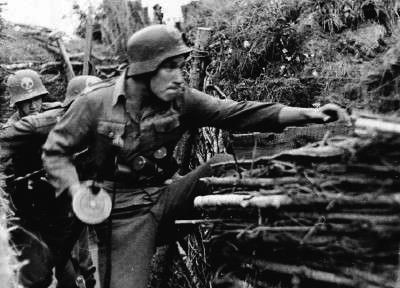 |
Assault on the Svir River
By Scott Elaurant
Recovering the frozen north...
After the initial German invasion had been repelled at Moscow in December 1941, the Soviet high command looked to take advantage of the German army’s unreadiness for winter fighting. This became a general winter counter-offensive along the length of the front, from the Black Sea to the Baltic. In the north Germany’s ally Finland had regained all the territory in Karelia the Soviets had taken after the Winter War in 1939-40. By the end of 1941 they settled into a defensive position on the Svir River, in an effort to hold on to it. |
|
The Soviets now set about getting some of it back again.
The Finnish forces that had joined the German attack in 1941 had been determined and well organised but lightly equipped. After the Finns switched over to a defensive posture, most of their tanks (captured Soviet T26s and BT7s) were withdrawn into reserve. Moreover, while the Finnish troops had fought fanatically in defence of their homeland in the Winter War, they were much less enthusiastic about invading Russia. By early 1942 the Finnish V Corps and VI Corps were strung out along the Svir River line.
|
|
The Soviet Plans and Forces
The Soviet Winter offensive had been a general one right across the front, from Odessa in the south to near Leningrad in the north. On the Finnish frontier, the Svir River was the main defensive barrier. If this obstacle could be breached, there was nothing to stop Soviet forces before they reached the now enemy occupied capital of Soviet Karelia, Petrozavodsk. From there they could force the Finns back across the border. The attack was also planned to coincide with an attack at Kechenga on the Misselka Isthmus further to the north.
The Soviet 7th Army was stationed on the Karelian front, and the attacking forces were drawn from it.
|
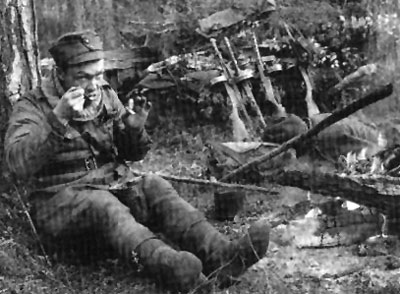 |
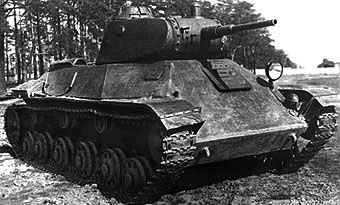 |
There were five divisions in this army, all infantry, but not all were used in the attack. The 7th Army had also received supplies of new weapons which were used, including KVIe and T50 tanks (similar to the T70).
The Svir River
The Karelian countryside around the Svir River is very flat, with large areas of swamp, some of the higher ground cleared for farming, and most being heavily forested. The Svir River is over 100 metres wide in places and although shallow, it represents a considerable obstacle to cross, especially by vehicles. It is frozen in winter with ice thick enough to cross, but by the time of this attack, the Spring thaw had begun.
|
The Attack
On 11th April 1942 a Soviet force consisting of one infantry division and two ski brigades attacked near the Svir River Power Plant at Volkhov. It was the weakest point of the Finnish lines – the gap between the end of the V Corps and VI Corps positions. The attackers achieved complete surprise, with the Finnish frontier defences caught largely unprepared. They successfully crossed the Svir and then made slow progress inland through initially light Finnish defences. |
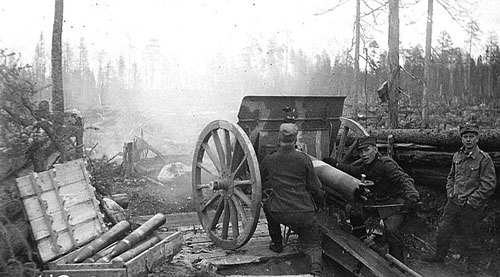 |
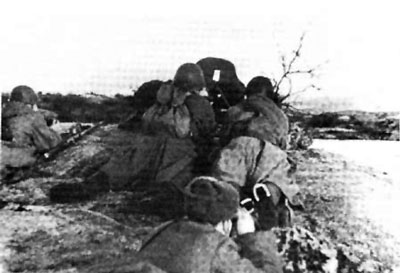 |
The infantry division was reinforced by heavy Soviet KV tanks, which led the attack. To these the Finns had no answer, with most of their anti-tank guns being light 37mm or captured Soviet 45mm guns. The greatest cause of delay was the swampy ground itself. The Finns were only dug into light trenches, and fell back.
The Counter-Attack
To respond to the attack, the Finnish headquarters brought up fresh troops. The Finnish 11th and 17th Divisions were in reserve and immediately switched on to counter attack. To deal with the KVIs, the Finns brought up some of their heavy Divisional anti-aircraft guns, to knock them out.
|
|
These were captured Soviet 76mm guns, (76mmITK31 in Finnish use), for which the Finns had also captured AP ammunition.
Elsewhere the Finns used their superior mobility to counterattack from the flanks, rather than at the point of the Soviet offensive.
The Game
The Finns must conduct a mobile defence (see new Motti Defence Mission below), while the Soviets attack. The advancing Soviet column aims to smash through the Finnish defences and reach the railway line located further north of the Volkhov power plant. They must be stopped. If possible, the defenders should counterattack from the flanks and stabilise the defence line again on the Svir River.
The Soviets on the other hand must crush the defenders and capture the Power Plant. It is the key, not only to holding Volkhov, but was the dominant feature in the flat area around the railway. From it, an attacker could continue north towards Petrozavodsk.
Deployment
The Finnish force defends and sets up first.
|
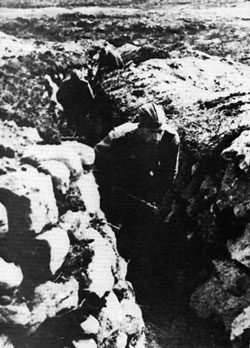 |
The two 11th Division Companies with the Anti-aircraft Guns are deployed on table, and the 17th Division Company is held off table as a Flank Attack. All other Motti Defence mission rules apply as normal.
Soviets deploy as attackers as per Motti Defence Mission rules. |
Forces
The actual battle was a large scale affair involving the attack of an entire Soviet Army Group of several Regiments. The forces shown here are representative of the relative size and types of forces used by each side, based on a standard sized game. If you who would prefer to play a bigger or smaller game, they could be scaled up or down. In that case the table size and time should also be adjusted accordingly. |
|
Soviet Divisional Assault Regiment at Svir River
| 1st Battalion, Divisional Assault (Rifle) Regiment ~ (page 285 of Eastern Front) |
|
Hero Rifle Battalion HQ
2x M1891 rifle team~ Command, 2IC, Komissar team, Anti-tank gun platoon with 45mm obr 1942 guns |
1 points |
Hero Rifle Company
10x DP MG and M1891 rifle team
1x Komissar team
1x Maksim HMG team
1x 50mm mortar team |
9 points |
Hero Rifle Company
10x DP MG and M1891 rifle team
1x Komissar team
1x Maksim HMG team
1x 50mm mortar team |
9 points |
Scout Platoon
7x PPSH SMG team |
10 points |
Maksim MG Company
6x Maksim HMG team |
4 points |
45mm Anti-tank Platoon
4x Long 45mm gun |
8 points |
| 2nd Battalion, Divisional Assault (Rifle) Regiment |
|
Hero Rifle Battalion HQ
2x M1891 rifle team |
1 points |
Hero Rifle Company
10x DP MG and M1891 rifle team
1x Komissar team
1x Maksim HMG team
1x 50mm mortar team |
9 points |
Hero Rifle Company
10x DP MG and M1891 rifle team
1x Komissar team
1x Maksim HMG team
1x 50mm mortar team |
9 points |
Scout Platoon
7x PPSH SMG team |
10 points |
Hero SMG Company
7x PPSh SMG team
1x Komissar team |
6 points |
45mm Anti-tank Platoon
4x Long 45mm gun |
8 points |
| Corps Support Units |
|
T-50 Tank Company
6x T-50 tanks (use T-70 (45mm) stats) |
8 points |
KV-1 Tank Company
4x KV-1 tanks |
32 points |
82mm Mortar Company
6x 82mm mortar |
4 points |
|
76mm Artillery Battery
4x 76mm gun
122mm Artillery Battery
4x 122mm howitzer
|
8 points
8 points
|
| Total |
153 points
|
|
|
Finnish Forces
| 11th Division ~ 1st Jalkaväki Kompannia (See page 146 of Eastern Front) |
|
Infantry Company HQ
2x Suomi SMG team |
2 points |
Infantry Platoon
9x M/27 rifle & M/26 MG team
1x Lahti anti-tank rifle team
Close Defence Command Card |
13 points |
Infantry Platoon
9x M/27 rifle & M/26 MG team
1x Lahti anti-tank rifle team
Close Defence Command Card |
13 points |
Infantry Platoon
9x M/27 rifle & M/26 MG team
Close Defence Command Card |
12 points |
Maxim HMG Platoon
4x Maxim HMG team |
6 points |
45mm Anti-tank Platoon
2x 45mm gun |
6 points |
76mm Anti-aircraft Platoon
2x 76mm anti-aircraft gun |
4 points |
| 11th Division ~ 2nd Jalkaväki Kompannia |
|
Infantry Company HQ
2x Suomi SMG team |
2 points |
Infantry Platoon
9x M/27 rifle & M/26 MG team
1x Lahti anti-tank rifle team
Close Defence Command Card |
13 points |
Infantry Platoon
9x M/27 rifle & M/26 MG team
1x Lahti anti-tank rifle team
Close Defence Command Card |
13 points |
Pioneer Platoon
7x M/27 rifle team
2x Flame-thrower team
Close Defence Command Card |
11 points |
76mm Artillery Battery
2x 76mm field gun |
5 points |
| 17th Division ~ Jalkaväki Kompannia |
|
Infantry Company HQ
2x Suomi SMG team |
2 points |
Infantry Platoon
9x M/27 rifle & M/26 MG team
1x Lahti anti-tank rifle team
Close Defence Command Card |
13 points |
Infantry Platoon
9x M/27 rifle & M/26 MG team
1x Lahti anti-tank rifle team
Close Defence Command Card |
13 points |
SMG Platoon
7x Suomi SMG team
Close Defence Command Card |
11 points |
Maxim HMG Platoon
4x Maxim HMG teams |
6 points |
81mm Mortar Platoon
3x 81mm mortat |
5 points |
45mm Anti-tank Platoon
2x 45mm gun |
6 points |
T-26 Armoured Platoon
5x T-26 |
8 points |
| Total |
166 points
|
|
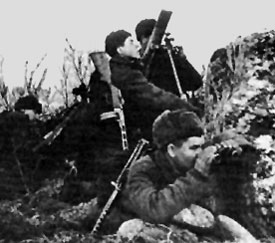 |
76 ITK/31 gun
Immobile, Range 32"/80cm, ROF 2, AT 11, FP 3+
Use the Dash speeds from the German 8.8cm AA gun.
For a model try using the Soviet 85mm with the muzzle brake cut off.
Historical Outcome
The KV-1 tanks were knocked out by the 76mm AA gun, and with their spearhead blunted, the Soviet attack ground to a halt at the front. Although the Finnish troops were almost solely infantry formations, the rugged nature of the terrain suited them, with close fighting allowing the Finnish infantry to exert their superiority. Finnish infantry were well equipped for this sort of close fighting, and used their Suomi sub-machine guns, and flamethrowers, with devastating effect.
|
| The Finnish Flank attacks were very successful, cutting off Soviet assault troops and isolating them from their supplies. Nevertheless, it still took several more days to force the Soviets out of pockets of resistance. By 17th April the attack had been completely defeated, and the front line was re-established on the Svir River. Soviet losses are unknown, but must have been heavy. |
Motti Defence Mission for Flames of War
Motti Defence Missions use the Reserves and Flank Attack special rules.
Motti Defence Battles represents the fluid fighting without clear front lines that often followed a major offensive in the vast forests of the Finno-Soviet Front. These battles were just as much an opportunity for the defender to counterattack as a chance for the attacker to complete the victory. The term "motti" means firewood, and refers to the tactic of using flank attacks to chop an attacker into pieces. |
|
Situation Report:
Your Orders:
Attacker: The breakthrough has been achieved! You are ordered to complete the drive to victory. Advance on the enemy, and take the final objective. Be careful to preserve your supply lines, as the front line is still unstable.
Defender: Our front line has suffered a temporary setback. Your are ordered to stabilise the situation, and ensure that the enemy does not reach any further. Some of the assault columns have become over extended and vulnerable to flank attacks.
Preparing for Battle:
1. Both players roll a die. The player scoring lowest decides which side of the table the defender sets up on. The other player then choses to attack or defend.
2. The defender places their objective on the attacker’s half of the table, within 12”/30cm of the rear table edge and more than 12”/30cm from each side table edge.
|
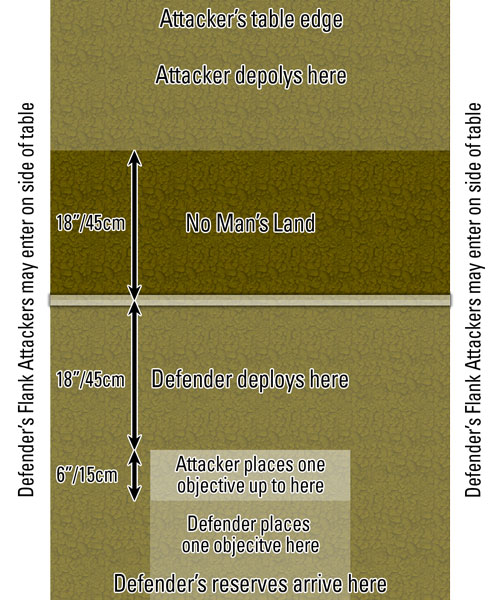 |
|
3. The attacker places their objective on the defender’s half of the table, within 18”/45cm of the rear table edge and more than 12”/30cm from each side table edge.
4. The defender places up to half of the platoons anywhere on their half of the table.
5. The defender holds the remainder of their Units off table as Reserves. These may all enter the board as either Immediate Reserves (defender starts rolling on turn 1), or Flank Attackers (Delayed Reserves) (defender starts rolling on turn 3), but not both.
6. The attacker places all Units on the table, within 18”/45cm of the rear edge.
|
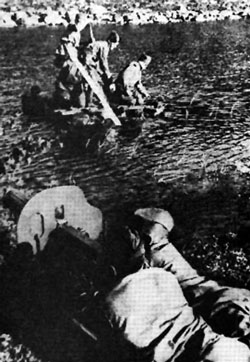 |
Beginning the Battle:
1. All Defender’s teams are assumed to not have moved at the start of the battle, so are in Foxhols and have Gone to Ground.
2. The Attacker has the first turn..
3. At the start of the defender’s first turn, the defender must decide whether to roll for Immediate Reserves or Delayed Reserves Flank Attackers. This decision applies for the rest of the game.
Ending the Battle:
The battle ends when either player starts their turn with teams in good order (not pinned, bailed out or bogged) within 2 inches of their objective and had held it for the previous turn, with no good order enemy team within 4 inches of the objective.
Deciding who won:
The player who ends a turn Holding an Objective has won the game.
|
|
Flank Attack Special Rule
When conducting a mobile defence, astute defending commanders may sometimes use the opportunity to counterattack from the flank.
Flank Attackers arrive as Delayed Reserves (page 104 of the Flames Of War rulebook) starting from turn 3 except they arrive from the flanks as indicated on the Mission Map. If you have selected to use Immediate Reserves you cannot also bring on Flank Attackers.
At the start of the third turn, the player rolls a die. On each roll of 5+, a reserve platoon arrives at either side table edge.
On each subsequent turn the player rolls one more die than the previous turn, so on turn four, the player rolls two dice, on turn five they roll three dice, and so on. Each roll of 5+ brings another platoon on from reserves.
|
Last Updated On Friday, October 14, 2022 by Wayne at Battlefront
|
|
|